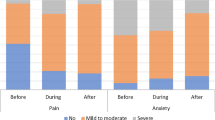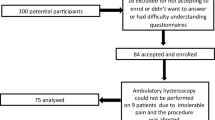Abstract
Objective
To evaluate the use of tenaculum on pain perception of patients and on ease of endometrial sampling procedure with a pipelle.
Methods
A randomized controlled trial was conducted in 118 patients for assessing pain perception and the ease of the procedure. Patients were randomly assigned to group 1 (without tenaculum) and group 2 (with tenaculum). Visual analog scale (VAS) was used to assess patients’ pain at four different times during the process. VAS-3 reflected the pain during the procedure. Likert scale was employed by the surgeon to measure the ease of the procedure. Main outcome was VAS and the secondary outcomes were Likert scale and success rate in obtaining adequate samples of endometrial tissue for histopathological diagnosis.
Results
Endometrial sampling procedure could not be performed only on three patients who belonged to group 1. The VAS-3 scores were higher in group 2 than group 1 (p = 0.001). Nullipar patients had higher VAS-3 scores than multipars (p = 0.012). VAS-3 did not vary in pre-peri-postmenopausal women (p = 0.901). Likert scale was lower in postmenopausal women than peri- or pre-menopausal patients (p = 0.020, 0.017, respectively). Use of tenaculum was found by logistic regression analysis to be an independent risk factor for patients’ pain perception (p = 0.0001, RR 31.8, 95 % CI 8.3–122.4). Inadequate endometrial sampling was reported in 12 patients who were all postmenopausal.
Conclusion
Endometrial sampling procedure without tenaculum is feasible and yields less pain perception than with tenaculum.

Similar content being viewed by others
References
Leclair CM, Zia JK, Doom CM, Morgan TK, Edelman AB (2011) Pain experienced using two different methods of endometrial biopsy: a randomized controlled trial. Obstet Gynecol 117(3):636–641
Dijkhuizen FPHLJ, Mol BWJ, Brölmann HAM, Heintz APM (2000) The accuracy of endometrial sampling in the diagnosis of patients with endometrial carcinoma and hyperplasia: a meta-analysis. Cancer 89:1765–1772
Guida M, Di Spiezio Sardo A, Acunzo G, Sparice S, Bramante S, Piccoli R, Bifulco G, Cirillo D, Pellicano M, Nappi C (2006) Vaginoscopic versus traditional office hysteroscopy: a randomized controlled study. Hum Reprod 21(12):3253–3257
Trolice MP, Fishburne C Jr, McGrady S (2000) Anesthetic efficacy of intrauterine lidocaine for endometrial biopsy: a randomized double-masked trial. Obstet Gynecol 95:345–347
Sagiv R, Sadan O, Boaz M, Dishi M, Schechter E, Golan A (2006) A new approach to office hysteroscopy compared with traditional hysteroscopy: a randomized controlled trial. Obstet Gynecol 108:387–392
Liberty G, Gal M, Halevy-Shalem T, Michaelson-Cohen R, Galoyan N, Hyman J, Eldar-Geva T, Vatashsky E, Margalioth E (2007) Lidocaine–Prilocaine (EMLA) cream as analgesia for hysterosalpingography: a prospective, randomized, controlled, double blinded study. Hum Reprod 22(5):1335–1339
Sharma M, Taylor A, Spiezio SA, Buck L, Mastrogamvrakis G, Kosmas I et al (2005) Outpatient hysteroscopy: traditional versus the ‘no-touch’ technique. BJOG 112:963–967
Madari S, Al-Shabibi N, Papalampros P, Papadimitriou A, Magos A (2009) A randomised trial comparing the H Pipelle with the standard Pipelle for endometrial sampling at ‘no-touch’ (vaginoscopic) hysteroscopy. BJOG 116:32–37
Anserini P, Delfino F, Ferraiolo A, Remorgida V, Menoni S, De Caro G (2008) Strategies to minimize discomfort during diagnostic hysterosalpingography with disposable balloon catheters: a randomized placebo-controlled study with oral nonsteroidal premedication. Fertil Steril 90(3):844–848
Einarsson JI, Henao G, Young AE (2005) Topical analgesia for endometrial biopsy: a randomized controlled trial. Obstet Gynecol 106(1):128–130
Dogan E, Celiloglu M, Sarihan E, Demir A (2004) Anesthetic effect of intrauterine lidocaine plus naproxen sodium in endometrial biopsy. Obstet Gynecol 103:347–351
Williams A, Brechin S, Porter A, Warner P, Critchley H (2008) Factors affecting adequacy of Pipelle and Tao Brush endometrial sampling. BJOG 115:1028–1036
Fakhar S, Saeed G, Khan AH, Alam AY (2008) Validity of pipelle endometrial sampling in patients with abnormal uterine bleeding. Ann Saudi Med 28(3):188–191
Elsandabesee D, Greenwood P (2005) The performance of Pipelle endometrial sampling in a dedicated postmenopausal bleeding clinic. J Obstet Gynaecol 25(1):32–34
Huang GS, Gebb JS, Einstein MH, Shahabi S, Novetsky AP, Goldberg GL (2007) Accuracy of preoperative endometrial sampling for the detection of high-grade endometrial tumors. Am J Obstet Gynecol 196:243.e1–243.e5
Bakour SH, Khan KS, Gupta JK (2000) Controlled analysis of factors associated with insufficient sample on outpatient endometrial biopsy. BJOG 107(10):1312–1314
Bhide A, Gangji A, Anyanwu L (2007) Endometrial biopsy: a pilot study of instrument used; Pipelle vs infant feeding tube. J Obstet Gynaecol 27(8):838–839
Naim NM, Mahdy ZA, Ahmad S, Razi ZR (2007) The Vabra aspirator versus the Pipelle device for outpatient endometrial sampling. Aust N Z J Obstet Gynaecol 47(2):132–136
Dacco’ MD, Moustafa M, Papoutsis D, Georgantzis D, Halmos G, Magos A (2012) An audit of using the H Pipelle for endometrial sampling at outpatient hysteroscopy and literature review comparison with the Pipelle de Cornier. Eur J Obstet Gynecol Reprod Biol 165(2):299–301
McCluggage WG (2006) My approach to the interpretation of endometrial biopsies and curettings. J Clin Pathol 59(8):801–812
Acknowledgments
We thank Assoc. Prof. Dr. Gulsah Seydaoglu for statistical analysis of the study, Prof. Dr. Derya Gumurdulu for histopathological examinations and Nuran Kokmen for her assistance in endometrial sampling procedure.
Conflict of interest
None.
Author information
Authors and Affiliations
Corresponding author
Additional information
Clinical Trial Registration: ClinicalTrials.gov, http://www.clinicaltrials.gov NCT01506778.
Rights and permissions
About this article
Cite this article
Kucukgoz Gulec, U., Khatib, G., Guzel, A.B. et al. The necessity of using tenaculum for endometrial sampling procedure with pipelle: a randomized controlled study. Arch Gynecol Obstet 289, 349–356 (2014). https://doi.org/10.1007/s00404-013-3005-7
Received:
Accepted:
Published:
Issue Date:
DOI: https://doi.org/10.1007/s00404-013-3005-7




